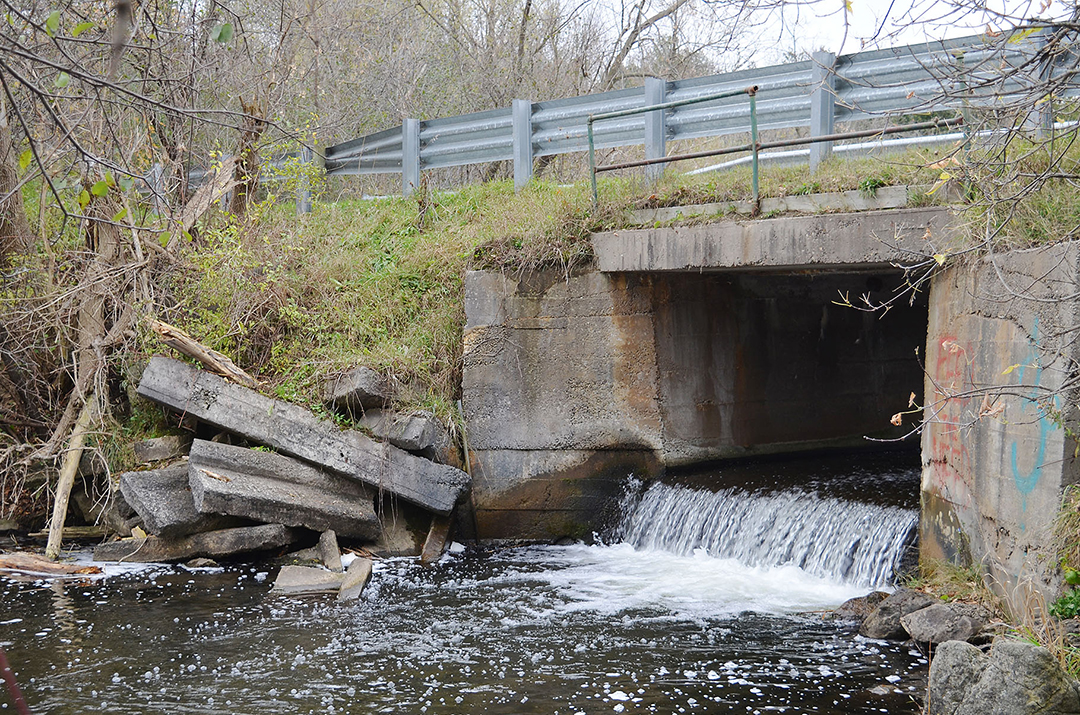After decades of warnings about its deteriorating condition, the Town of Erin will consider decommissioning Hull’s Dam, which creates the upper pond in Erin village.
Road superintendent Greg Delfosse brought up the topic at a budget workshop on Nov. 14, while discussing his department’s priorities.
“Another initiative I’d like to move forward on is to eliminate Hull’s Dam on Churchill Lane,” he said.
“It’s in severe need, and having discovered that the Ministry of Natural Resources (MNR) is happy to not have as many dams in Ontario as we do, I think it’s in the interest of the town to get rid of one of our two dams.”
The town owns Hull’s Dam, and has partial ownership of the Station Street Dam in Hillsburgh, which is being rehabilitated. The Charles Street and Stanley Park dams in Erin village, and four others near Hillsburgh, are privately owned.
An environmental assessment (EA) may be required to remove Hull’s Dam. No money has been allocated for an EA in 2019, and there is no estimate of the eventual project cost.
“We are currently working with Triton Engineers and the Credit Valley Conservation to see if an EA will need to be completed,” said communications officer Jessica Spina.
Hull’s Dam has historical significance, since Erin’s second sawmill was built there in 1845, then a millrace in 1849 to divert water through the downtown area, to power a grist mill on the opposite side of Main Street.
Last year the town received a presentation on dams from John Sinnige, senior manager of flood risk and water resources at Credit Valley Conservation (CVC).
He recommended the town have an engineering assessment on Hull’s Dam to determine the hazard potential classification. That has not been done.
If the classification is high, a dam safety review could be done.
The MNR sets dam standards and is responsible for dam safety and the CVC monitors flooding issues, but dam owners have liability in the event of a failure.
Sinnige said regulators cannot normally force a dam owner to bring their dam into compliance with current standards. MNR does get involved, however, when changes are planned, as happened at Station Street.
A 1994 report for the Village of Erin and CVC warned that both Hull’s Dam and the Charles Street Dam should have frequent inspections.
It said cracked concrete should be replaced and that other erosion protection should be installed to reduce the risk of embankment failure and downstream flooding.
At the time the village and CVC had a Credit River Restoration Committee, which discussed possible which discussed possible ways of gradually naturalizing the river closer to its original course by lowering the dams, but not removing them.
Possible designs included rock-lined channels and smaller ponds, but no action was taken.
In 1997, CVC’s West Credit Subwatershed Study stated: “Two dams located on the West Credit at Church Street [Hull’s Dam] and Charles Street in the Village of Erin have been found to be structurally inadequate by current standards.”
It predicted increased urbanization would cause greater risk of flooding.
The Charles Street Dam, built in 1826, was partially owned for many years by the Mundell family, with water from the pond powering its mill at the lumber yard on the east side of Main Street.
The dam interest and lumber yard were sold in 2017 .
In 2010, former Erin water superintendent Frank Smedley warned council that inspections, a long-term safety review and various plans for operation, maintenance and upgrades could cost from $105,000 to $240,000 per dam – not including capital costs of actual upgrades.
“These requirements will require significant staff resources that we do not have,” he said.
“The initial, capital and ongoing cost will also be significant and may impact the tax rate. It is likely the Hull’s Dam will need rebuilding due to being in poor condition. The cost is likely to be substantial.
“Decommissioning this structure may be the best option.”
In 2015, the upper pond at Hull’s Dam was virtually drained in the last week of July after at least two of the wooden boards used to control the water deteriorated, exposing mud flats that emitted a strong odour.
In a report shortly afterwards to town council, former road superintendent Larry Van Wyck said Hull’s Dam “suffers from years of neglect – the concrete portion of the dam on the face is in very poor condition.”
Wellington County’s Community Emergency Management Coordinator Linda Dickson assured councillors there was no immediate public safety issue.
The boards were replaced and large concrete blocks were placed in the water to partially protect the crumbling concrete of the dam.
CVC normally prefers the removal of dams, since this lowers the temperature of river water, creating better conditions for fish.
In 2017, CAO Deborah Martin-Downs said CVC does not advocate removing all dams.
“While removal is often a preferred fisheries option, we understand that there are other factors involved in the decision and that removal may not be possible or desirable,” she said.
“We do want good process around dam removals. No one has more experience around dams in the Credit than our team, so we are more than prepared to assist in identifying the risks and defining mitigation strategies.”
Decommissioning dams normally turns ponds into wetland swamps, which CVC says benefit the environment and act as a natural defence against flooding by absorbing water during storms.
A recent study showed wetlands could reduce financial costs of floods by up to 38 per cent.




